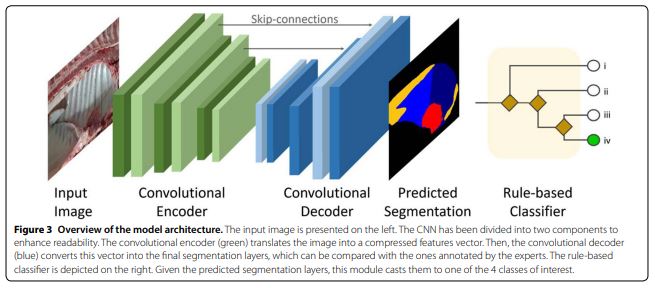

Automatic Detection of Abattoir Lesion
The slaughterhouse is widely regarded as an important control point for monitoring the health status of farm animals, especially in pigs. Despite the important role of the abattoir for monitoring key diseases in the pig industry, scoring is currently only performed on a small percentage of slaughtered pigs. This is due to the significant costs involved in having all carcasses monitored by trained experts physically present along the slaughter line.
Because of the costs involved in manual scoring and the advantage of providing systematic data, efforts are being made to develop new and innovative scoring methods. Such methods must be simple, fast, easily standardised and provide data suitable for monitoring animal diseases for statistical analysis.
Artificial Intelligence technologies can be very effective in fully automating the monitoring of animal diseases in slaughterhouses, completely eliminating the need for trained employees. Automated systems would allow systematic monitoring of all slaughtered animals for key diseases.

WHAT IS ADAL
AImageLab, in collaboration with Farm4Trade and the Department of Veterinary Medicine of the University of Teramo (UNITE), has developed the Automatic Detection of Abattoir Lesion or "ADAL" system, the first animal production system that applies deep learning techniques with the aim of significantly increasing ecological and sustainable food production.
ADAL wants to develop and deploy an automated mass data capture system for respiratory diseases in slaughtered pigs. By installing sensors and cameras along the slaughter line, photos of carcasses and organs are captured and analysed by the AI system to detect the presence and severity of diseases.
ADAL consists of a system of convolutional neural networks (CNNs), trained to automatically analyse and score images of pigs slaughtered for pleurisy. The system works by analysing photographic images of half pig carcasses, scoring them from 0 (unaffected animals) to 3 (severely affected animals), based on the absence or presence and extent of pleurisy detected. The technology was developed using a large number of images of half carcasses photographed in commercial slaughterhouses. The images were all assessed and segmented by veterinary specialists to train CNNs to recognise and score the disease. The scores given are then used to assess the prevalence and extent of the disease in the batch of slaughtered animals. The identification of lung lesions at this stage of production allows both the supplier and the farm to assess the impact of the animal disease on product quality and therefore on the entire production and supply process.
The acquired data will be automatically processed and returned in comprehensive reports, allowing an immediate and complete view of the results of each inspection within minutes of its execution. All data will be stored either locally (and accessible in real time) or on dedicated cloud storage. All data can be checked, read and further evaluated or rechecked remotely at any time by anyone who has gained access to the platform, including third parties such as veterinarians or other interested parties.
ADAL proved to be very capable of recognising and scoring pleurisy in slaughtered pigs. In fact, it showed an average accuracy rate of 85.5% for its ability to distinguish between classes. The system recognised healthy carcasses with 96% accuracy, while diseased carcasses (regardless of score) were recognised with 92% accuracy. Carcass inspections of slaughtered animals, which until now have been carried out manually, become faster, more accurate, automated and cheaper.
Research is currently underway to expand the ADAL technology to other key disease conditions. In fact, recently developed CNNs are already showing results and they are trained to recognise and mark swine pneumonia. ADAL technology will be developed for a range of diseases and can be adopted on a large scale in commercial slaughterhouses, contributing to more robust animal health monitoring strategies.
The main benefits of this system include:
- It makes it possible to routinely assess all slaughtered carcasses for major diseases, thus providing more complete, accurate and valuable information to abattoirs, farmers, veterinary services, pharmaceutical companies and health institutions;
- It provides huge amounts of data, suitable for statistical analysis, appropriate for integration with on-farm health data to optimise herd health management;
- Slaughterhouse data can be used in prevention and treatment programmes, leading to improved livestock industry practices that can positively influence major growing global problems, such as food supply, food waste, livestock productivity, food quality and traceability, animal welfare, use of natural resources and reduction of antibiotic use;
- These data can be used by stakeholders, such as large animal veterinarians and farmers, to manage herd health;
- The data can also be used by official government animal health monitoring agencies to manage animal diseases and to streamline national livestock health monitoring and control strategies;
- ADAL allows significant cost reduction.
Publications
| 1 |
Trachtman, A. R.; Bergamini, L.; Palazzi, A.; Porrello, A.; Capobianco Dondona, A.; Del Negro, E.; Paolini, A.; Vignola, G.; Calderara, S.; Marruchella, G.
"Scoring pleurisy in slaughtered pigs using convolutional neural networks"
VETERINARY RESEARCH,
vol. 51,
pp. 51
-61
,
2020
| DOI: 10.1186/s13567-020-00775-z
Journal

|
Project Info
